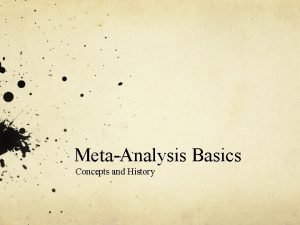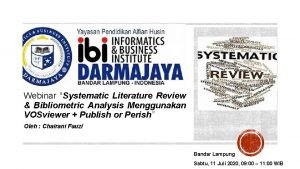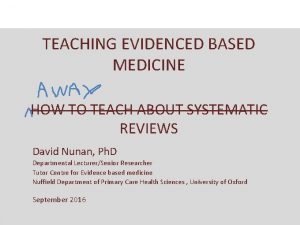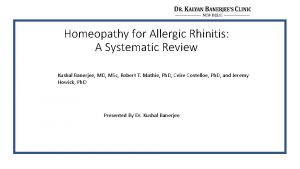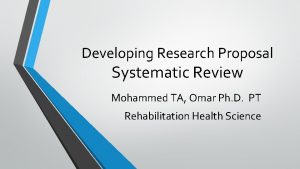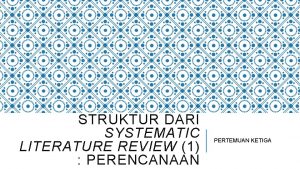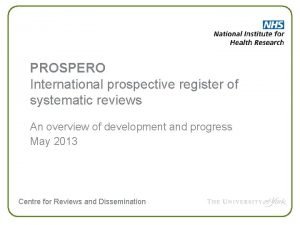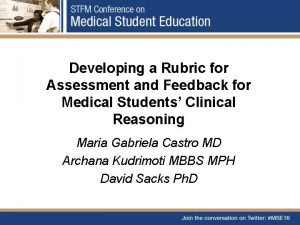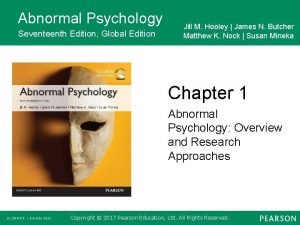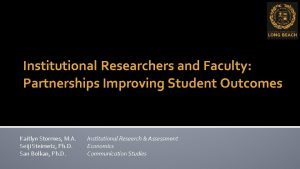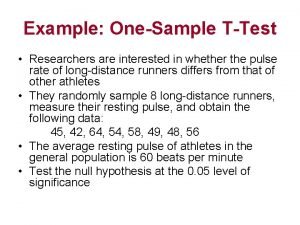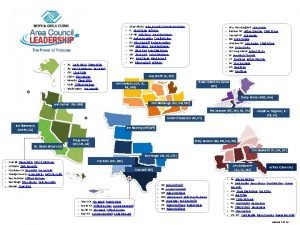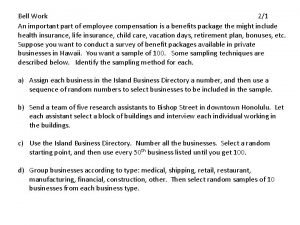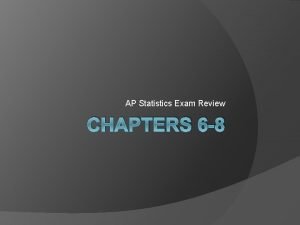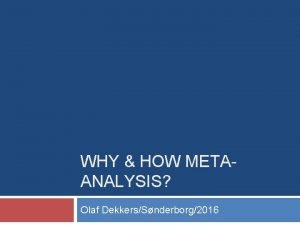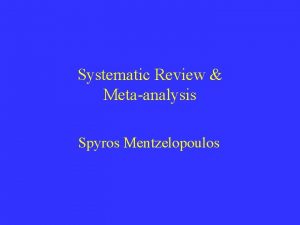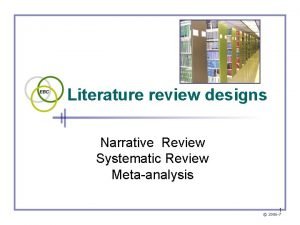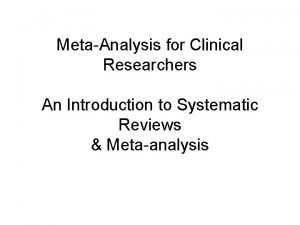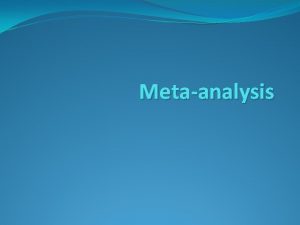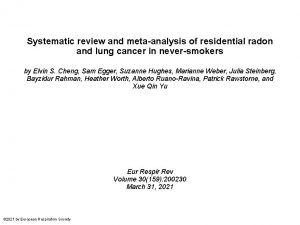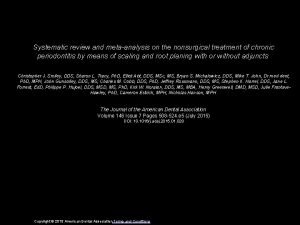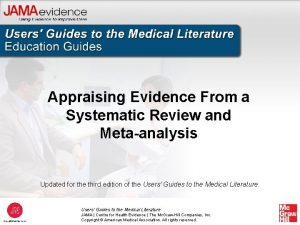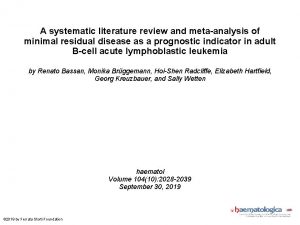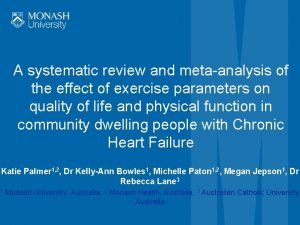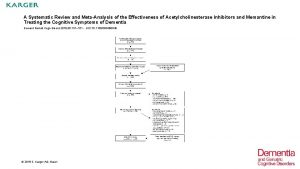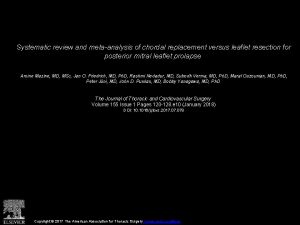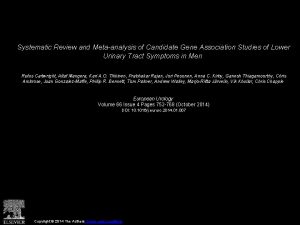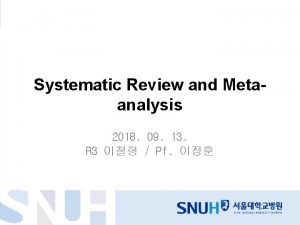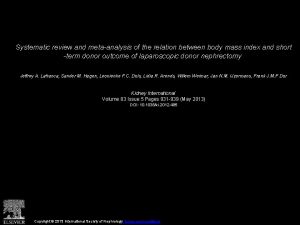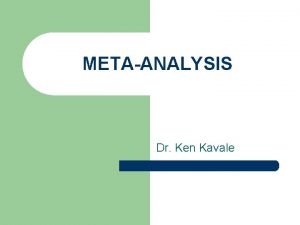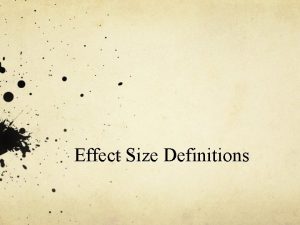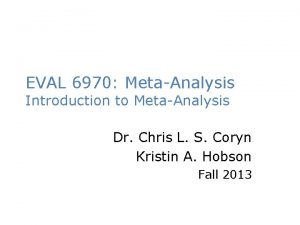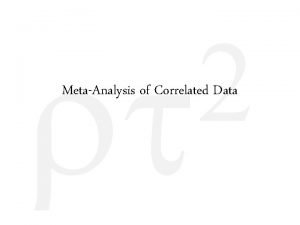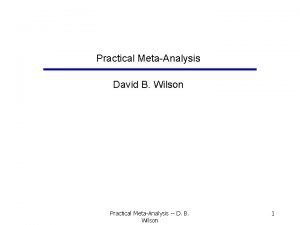Advanced Statistics for Researchers Metaanalysis and Systematic Review

























- Slides: 25

Advanced Statistics for Researchers Meta-analysis and Systematic Review Avoiding bias in literature review and calculating effect sizes Dr. Chris Rakes October 9, 2013 With Special Thanks to Dr. Jeff Valentine

Research Statistics Framework Conceptual Framework(s) Research Design, Missing Data, Statistical Assumptions, Measurement Reliability & Validity Descriptive & Inferential Statistics w/ Probability General Linear Model • (M)AN(C)OVA • Simple and Multiple Regression • Exploratory Factor Analysis Qualitative Data Analysis Writing for Publication Meta-Analysis Structural Equation Modeling Hierarchical Linear Modeling Item Response Theory Bayesian Estimation Secondary Data Analysis

In this Session �Using Systematic Review to Obtain a Better Literature Review/Conceptual Framework �Minimizing Publication Bias �How to compute various types of effect sizes �Fixed vs. Random Effects �Computing a Design Effect

USING SYSTEMATIC REVIEW TO OBTAIN A BETTER LITERATURE REVIEW/CONCEPTUAL FRAMEWORK

Why Systematic Review? �Synthesis of results of multiple studies provides more compelling evidence than results of any single study. ◦ Less effected than single studies by sampling error ◦ More confidence in results: place single studies in context

Problems with Narrative Reviews �Literature search virtually never thorough in scope or in reporting how literature was located. �Under-reported methodology (why were certain studies included or excluded? ) ◦ Often unstated, virtually always arbitrary ◦ Potential Confirmation Bias �Conflate statistical significance with effect size �Ignore Type II error in primary studies �Ignore publication bias �Often employ vote counts

Steps for a Systematic Review �Goal: Uncover All Relevant Studies �More realistic goal: Minimize differences between retrieved and unretrieved studies. All Relevant Studies All Retrievable Relevant Studies Retrieved Studies Population of Studies Accessible Population Sample

Searching Electronic Databases consult with a professional librarian!!!! �Identify potentially relevant databases. �Search terms must appear in an indexed field. �Always ◦ Often must be exhaustive with terms �Deep substantive knowledge of the research questions is required to capture the relevant terms �Strongly susceptible to disciplinary bias (vet thoroughly) �Full text search capability will help some

Gray Literature �Generic search engines such as Google and Google Scholar can sometimes help identify unpublished material �Pro. Quest Dissertations and Theses will house dissertation research http: //aok. lib. umbc. edu/databases/dblink. php? DBID=370 �Research Organizations in Your Field often house technical reports on their websites (e. g. , CRESST) �Bibliographies of already-identified relevant studies.

Publication Bias �Known difference in statistical significance of published vs. unpublished studies. �The best defense is a comprehensive, systematic search for literature.

Key Decisions in Literature Review �Inter-Rater Agreement on Key Decisions ◦ Does the study look like it might be relevant? �If yes, retrieve full text of article. ◦ Is the study eligible for inclusion? �Base final decision on full text. �Double code as much as possible.

Browse UMBC’s Databases

COMPUTING EFFECT SIZES

Statistical Significance �Interpretation of a p-value ◦ Given a true null hypothesis, the probability of observing a relationship at least as large as the one being tested. ◦ The confidence we can state the direction of a relationship (positive or negative) ◦ Likelihood that a result is due to random chance (i. e. , sampling error). �A p-value is a function of sample size and effect size.

Effect Size �Estimates the magnitude (size) of a relationship (i. e. , how much impact? ) �Three families of effect size ◦ Correlation Coefficients (r) ◦ Odds Ratios (OR; Two Dichotomous Variables) ◦ Mean Differences (d)

The role of sample size �Any non-zero difference in means will be statistically significant given a large enough sample. Assume: ◦ MT = 100. 1, MC = 100. 0, sp = 15 n per group 100000 200000 d t-test p-value 0. 01 0. 962 0. 01 0. 882 0. 01 0. 637 0. 01 0. 136 0. 01 0. 035

Two categories of Effect Sizes �Unstandardized ◦ Effects expressed directly in terms of the measured outcome (e. g. , “ 3 points on an IQ scale”) ◦ Most useful when scale is well understood and relevant studies all use the same scale. �Standardized: transforming effects to have similar meaning across scales ◦ Standard Deviation Units ◦ Percent Change ◦ Proportion of Variance Explained

Computing an Odds Ratio Graduated Didn’t Graduate Treatment 2 (a) 6 (b) Control 9 (c) 12 (d)

Standardized Effect Size: Mean Difference (d or Cohen’s d) � Study n 1 Ȳ 1 s 1 (s 1)2 n 2 Ȳ 2 s 2 (s 2)2 1 59 17. 25 3. 26 10. 6276 50 19. 32 3. 53 12. 4609

Computing ES: An Example Study n 1 Ȳ 1 s 1 (s 1)2 n 2 Ȳ 2 s 2 (s 2)2 1 59 17. 25 3. 26 10. 6276 50 19. 32 3. 53 12. 4609 �

Weighting Effect Sizes �

Try It! Go to http: //csrakes. yolasite. com for the template n 1 5 35 Ȳ 1 3. 3 1. 5 s 1 1. 2 0. 5 n 2 17 17 32 32 Ȳ 2 4. 2 3 3 s 2 0. 7 0. 5

Conversion Formulas �Cooper, H. (1998). Synthesizing research. Thousand Oaks, CA: Sage. �If mean, SD, and n available, use regular formula �Convert from r, t, F(1, X), and dichotomous proportions

Software �Comprehensive Meta-Analysis: http: //www. metaanalysis. com/index. php? gclid=CITZk 8 WSiro. CFRCg 4 Aod. Jh. YA 7 Q �Microsoft Excel: Home-made formulas

Questions? �rakes@umbc. edu �http: //csrakes. yolasite. com
 What is metaanalysis
What is metaanalysis Comprehensive metaanalysis
Comprehensive metaanalysis Nader amin-salehi
Nader amin-salehi Narrative review vs systematic review
Narrative review vs systematic review Narrative review vs systematic review
Narrative review vs systematic review Literature review dalam penelitian
Literature review dalam penelitian Qfas systematic review
Qfas systematic review Dr. kushal banerjee
Dr. kushal banerjee Prospero review registration
Prospero review registration Research proposal systematic review
Research proposal systematic review Contoh critical appraisal jurnal systematic review
Contoh critical appraisal jurnal systematic review Pain history taking
Pain history taking Pengertian systematic review
Pengertian systematic review International prospective register of systematic reviews
International prospective register of systematic reviews Systematic review in history taking
Systematic review in history taking Introduction to statistics what is statistics
Introduction to statistics what is statistics Researchers who are studying a new shampoo
Researchers who are studying a new shampoo What is the cardinal rule of naturalistic observation
What is the cardinal rule of naturalistic observation Newborn infants typically prefer
Newborn infants typically prefer Analogue studies are used when researchers ____.
Analogue studies are used when researchers ____. Researchers
Researchers Difference between independent and one sample t test
Difference between independent and one sample t test Medical researchers discover that eating lucky charms
Medical researchers discover that eating lucky charms Steve ratto
Steve ratto Medical researchers followed 6272 swedish
Medical researchers followed 6272 swedish Chapter 6 ap statistics review
Chapter 6 ap statistics review
